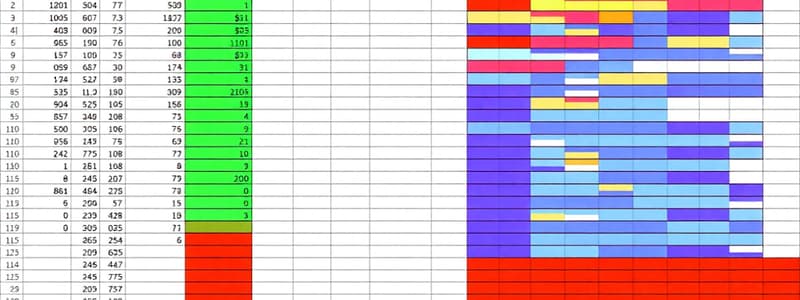Podcast
Questions and Answers
Which conditional formatting feature uses visual bars to represent values?
Which conditional formatting feature uses visual bars to represent values?
- Color Scales
- Highlight Cells Rules
- Data Bars (correct)
- Icon Sets
What does conditional formatting generally apply based on?
What does conditional formatting generally apply based on?
- Cell values or formulas (correct)
- The current date
- Number of characters in a cell
- Font style only
Which of these is a type of conditional formatting rule?
Which of these is a type of conditional formatting rule?
- Left/Right Rules
- Top/Bottom Rules (correct)
- Center Rules
- Diagonal Rules
What happens when you 'Clear Rules'?
What happens when you 'Clear Rules'?
Which feature would you use to apply a gradient of colors based on cell values?
Which feature would you use to apply a gradient of colors based on cell values?
Where can you view and edit conditional formatting rules?
Where can you view and edit conditional formatting rules?
Where do you create a new conditional formatting rule?
Where do you create a new conditional formatting rule?
Which conditional formatting option uses symbols to represent cell values?
Which conditional formatting option uses symbols to represent cell values?
What does the 'Stop If True' option do?
What does the 'Stop If True' option do?
Which of these conditionally formats based on a specific value?
Which of these conditionally formats based on a specific value?
Which tool would you use to remove conditional formatting from a selected area?
Which tool would you use to remove conditional formatting from a selected area?
If you want to visually compare values in a range, which is most suitable?
If you want to visually compare values in a range, which is most suitable?
If multiple conditional formatting rules apply, how do you adjust the order?
If multiple conditional formatting rules apply, how do you adjust the order?
The 'Top/Bottom Rules' help highlight what?
The 'Top/Bottom Rules' help highlight what?
Which of these does conditional formatting change?
Which of these does conditional formatting change?
Flashcards
Conditional Formatting
Conditional Formatting
Rules that apply formatting based on cell values or formulas.
Top/Bottom Rules
Top/Bottom Rules
Rules that highlight the top or bottom values in a range.
Highlight Cells Rules
Highlight Cells Rules
Rules that apply formatting based on specific criteria.
Data Bars
Data Bars
Signup and view all the flashcards
Color Scales
Color Scales
Signup and view all the flashcards
Icon Sets
Icon Sets
Signup and view all the flashcards
Manage Rules
Manage Rules
Signup and view all the flashcards
New Rule
New Rule
Signup and view all the flashcards
Stop If True
Stop If True
Signup and view all the flashcards
Clear Rules
Clear Rules
Signup and view all the flashcards
Study Notes
- Rules applying formatting based on cell values or formulas are collectively known as Conditional Formatting. This sophisticated feature provides users with the opportunity to visually enhance and manipulate spreadsheet data by applying specific formatting styles dictated by predetermined conditions or thresholds. Utilizing conditional formatting is essential for effective data analysis and interpretation; it empowers users to quickly identify trends, patterns, and anomalies within vast datasets. By transforming the way data is displayed, it allows for a more interactive and intuitive experience when reviewing information. For example, users can make data more approachable and less overwhelming by highlighting critical values or trends, enabling quicker decision-making processes.
- Top/Bottom Rules are tailored specifically to highlight either the highest or lowest values found within a selected range of cells. This functionality proves beneficial in various scenarios, particularly when there is a need to perform rapid analyses of performance metrics or to identify outliers that may require further investigation. For instance, in a sales report, highlighting the top 10% of sales figures enables stakeholders to easily identify which products or salespeople are excelling, allowing for targeted recognition or further exploration of successful strategies. The implementation of these rules can draw immediate attention to outstanding or subpar performances, facilitating data-driven decision-making.
- Highlight Cells Rules empower users to apply formatting based on specific, user-defined criteria. These criteria can vary widely, being based on exact numerical values, specific dates, or even text contained within the cells. For example, one might want to highlight all cells containing values that exceed a particular threshold to draw attention to high sales figures within an expense report. This clear visual indication can enhance the analysis by making critical data stand out, thus helping users quickly review results and identify areas requiring attention or further analysis. The flexibility to customize highlight rules makes this feature particularly advantageous for tailored data presentations.
- Data Bars serve as a compelling visual representation of the relative size of cell values within a defined range. By displaying colored bars directly within the individual cells, users can interpret the data at a glance without needing to analyze numbers manually. The length and fill level of each bar correspond to the value it represents—the longer or more filled a bar is, the greater the value indicated. This visual method facilitates swift comparisons between entries, offering instantaneous insights into performance disparities, trends, or distributions across datasets.
- Color Scales employ gradients of colors to illustrate the relationships among values within a dataset. For instance, a series of cells may be formatted so that lower values are represented in lighter shades while higher values are shown in darker hues, creating a pleasing and informative visual color gradient. This technique not only aids in quickly assessing where a dataset stands relative to its minimum and maximum limits, but also enhances the user’s ability to recognize patterns and draw conclusions from the data. By employing color to signify value ranges, users can reinforce their understanding of data distributions intuitively.
- Icon Sets grant users the capability to represent cell values using visually distinct icons instead of solely relying on numeric representations or textual formats. The icons can depict common symbols, such as traffic lights, arrows, or other recognizable shapes, thus providing intuitive visual cues about the status or magnitude of the data. This visual differentiation can help users quickly grasp information regarding trends, categorizations, or thresholds, enriching the data interpretation process with a straightforward visual language.
- Manage Rules is a dedicated area within the software that allows users to view, edit, and delete existing conditional formatting rules that have been established. This centralized location provides a comprehensive overview of all active formatting rules applied to the selected range, facilitating the easier management of complex formatting schemes. In instances where multiple rules may affect the same set of data cells, utilizing the manage rules feature becomes invaluable, as it ensures that users can enforce consistency and clarity in their visual data representation.
- New Rule represents the interface through which users can create new conditional formatting rules from scratch, tailored specifically to their data analysis needs. This feature offers a wide range of options for users, allowing them to define rules that align precisely with their requirements, thus supporting flexibility in how data can be visualized and interpreted. The ability to establish custom rules enables users to take a more hands-on approach to data visualization, ensuring that the resulting formats serve their unique analytical purposes effectively.
- Stop If True is a specialized option that allows users to prevent the application of multiple conditional formatting rules to the same cell simultaneously. This function is crucial in maintaining clarity, as it avoids the potential for confusion that could arise from conflicting visual cues when analyzing data. By ensuring that only the most relevant formatting is applied, users can enhance their data analysis process, making it easier to focus on the key insights that the data conveys, reducing the cognitive load involved in data interpretation.
- Clear Rules is a functionality that permits users to swiftly remove all conditional formatting applied to a selected range. This can be exceptionally useful when there is a need to reset the formatting for a new analysis session or when a previous formatting scheme is no longer applicable to the current data examination. The ability to quickly clear rules simplifies the process of maintaining an organized and relevant data presentation, allowing users to create a fresh slate for their visual formatting efforts as they delve into new analyses.
Studying That Suits You
Use AI to generate personalized quizzes and flashcards to suit your learning preferences.




